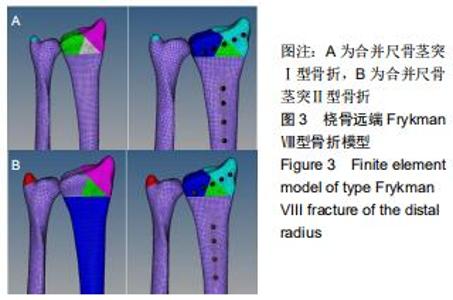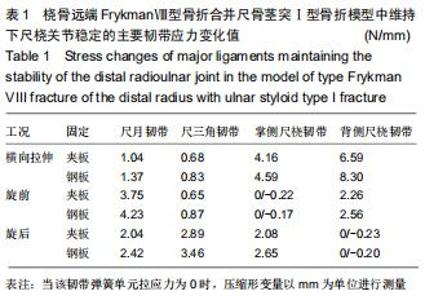Chinese Journal of Tissue Engineering Research ›› 2020, Vol. 24 ›› Issue (30): 4769-4774.doi: 10.3969/j.issn.2095-4344.2831
Previous Articles Next Articles
Finite element analysis of intervention of splint to ulnar column in the treatment of type Frykman VIII fracture of distal radius
Li Yongyao1, Zhao Yong1, Cheng Hao1, Xu Huiqing1, Wei Xu1, Liu Guangwei2, Cheng Yongzhong1, Cui Xin1
- 1Wangjing Hospital of China Academy of Chinese Medical Sciences, Beijing 100102, China; 2Beijing Key Laboratory of Traditional Chinese Medicine, Beijing 100700, China
-
Received:2020-01-18Revised:2020-01-20Accepted:2020-03-03Online:2020-10-28Published:2020-09-18 -
Contact:Cheng Hao, Chief physician, Master’s supervisor, Wangjing Hospital of China Academy of Chinese Medical Sciences, Beijing 100102, China -
About author:Li Yongyao, MD, Associate chief physician, Wangjing Hospital of China Academy of Chinese Medical Sciences, Beijing 100102, China -
Supported by:the Special Fund for Basic Scientific Research Business Fees of Central-Level Public Welfare Scientific Research Institutes, No. ZZ11-084; the Natural Science Foundation of Beijing, No. 7172243
CLC Number:
Cite this article
Li Yongyao, Zhao Yong, Cheng Hao, Xu Huiqing, Wei Xu, Liu Guangwei, Cheng Yongzhong, Cui Xin. Finite element analysis of intervention of splint to ulnar column in the treatment of type Frykman VIII fracture of distal radius[J]. Chinese Journal of Tissue Engineering Research, 2020, 24(30): 4769-4774.
share this article
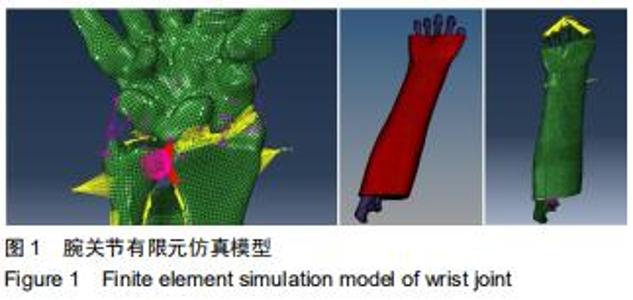
1.4.2 桡骨远端FrykmanⅧ型骨折有限元模型的构建 课题组前期基于Mimics软件已经建立了包含骨骼、韧带、关节软骨及软组织的正常腕关节有限元仿真模型(图1),并进行了有效性的验证[4]。现对该基础模型进行了增加尺桡骨髓腔的优化设计(图2左图),优化后模型单元数量为 859 409,节点数量为324 534。对模型轴向施加100 N载荷后计算出桡腕关节面接触应力最大值为10.6 MPa,获得的桡骨远端关节面应力分布云图(图2右图)与尸体实验报道得出的应力分布图基本吻合[5],证实了优化后模型的有效性。相关技术成果获得国家版权局计算机软件著作权登记(一种桡骨远端骨折的有限元建模系统,2019-7-10,登记号:2019SR1037684.)。 "
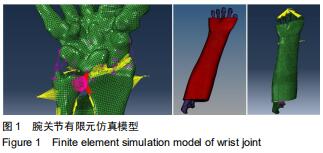
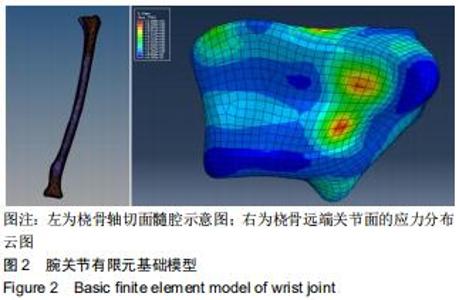
1.4.2 桡骨远端FrykmanⅧ型骨折有限元模型的构建 课题组前期基于Mimics软件已经建立了包含骨骼、韧带、关节软骨及软组织的正常腕关节有限元仿真模型(图1),并进行了有效性的验证[4]。现对该基础模型进行了增加尺桡骨髓腔的优化设计(图2左图),优化后模型单元数量为 859 409,节点数量为324 534。对模型轴向施加100 N载荷后计算出桡腕关节面接触应力最大值为10.6 MPa,获得的桡骨远端关节面应力分布云图(图2右图)与尸体实验报道得出的应力分布图基本吻合[5],证实了优化后模型的有效性。相关技术成果获得国家版权局计算机软件著作权登记(一种桡骨远端骨折的有限元建模系统,2019-7-10,登记号:2019SR1037684.)。 "
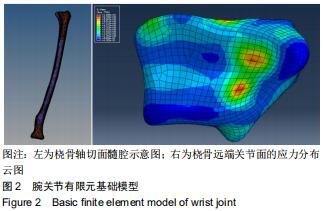
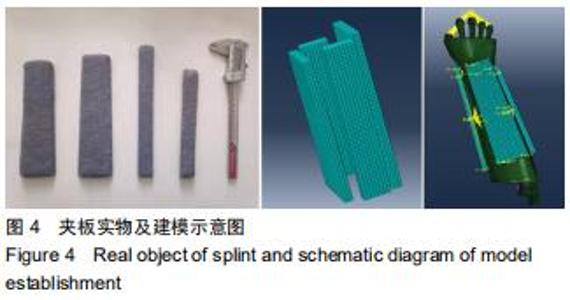
1.4.3 夹板有限元模型的构建及与骨折模型的组装 利用游标卡尺对小夹板进行尺寸测量,并在SolidWorks2016软件中对小夹板进行三维绘制,然后对小夹板进行分网,构建小夹板的三维有限元模型。以成人桡骨远端夹板的实物为参照,在软件中按照1∶1比例建立夹板仿真模型,严格按照尚天裕著《中国接骨学》中制定的标准位置组装。夹板固定骨折的力学机制是通过布带的约束力将力均匀分配传导到肢体上的,李想[6]对桡骨远端骨折中夹板束缚力进行了量化研究,参照其研究结果对每块夹板上均匀施加28 N载荷模拟绷带约束力,方向垂直于夹板表面,夹板与皮肤接触后开始计算,直至夹板与皮肤达到力学稳定,如此建立出实验所需夹板固定骨折的模型,用于模拟仿真夹板固定后的状态(图4)。夹板固定桡骨远端FrykmanⅧ型骨折模型(合并尺骨茎突Ⅰ型骨折)单元数量为866 384,节点数量为334 886(以下简称为Ⅰ型-夹板固定);合并尺骨茎突Ⅱ型骨折单元数量为866 312,节点数量为334 779(以下简称为Ⅱ型-夹板固定)。相关技术成果获得国家版权局计算机软件著作权登记(一种中医小夹板对桡骨远端骨折干预的有限元建模及分析系统,2019-7-10,登记号:2019SR1037948.)。 "

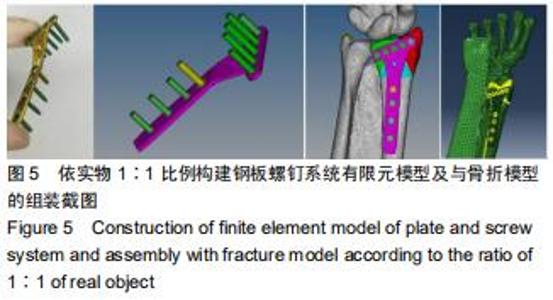
1.4.4 钢板螺钉系统有限元模型的构建及与骨折模型组装 在参考AO辛迪思公司桡骨远端2.4 mm锁定钢板螺丝钉系统手册所描述特征的基础上,利用游标卡尺对钢板及螺钉进行实际测量,根据所得数据在SolidWorks2016软件中进行钢板螺钉系统1∶1比例的三维绘制,绘制过程中对钢板的边缘倒角及螺钉螺纹进行简化处理,构建桡骨远端2.4 mm斜T型锁定钢板螺丝钉内固定系统的三维有限元模型。通过查阅有关内固定钢板参数的文献对不同位置的钢板、螺钉进行赋值后进行组装[7-8](图5)。据此建立出实验所需钢板固定骨折的模型,用于模拟仿真钢板固定后状态。钢板固定桡骨远端FrykmanⅧ型骨折合并尺骨茎突Ⅰ型骨折模型(以下简称为Ⅰ型-钢板固定)单元数量为875 765,节点数量为346 288;合并尺骨茎突Ⅱ型骨折(以下简称为Ⅱ型-钢板固定)单元数量为875 693,节点数量为346 181。 "
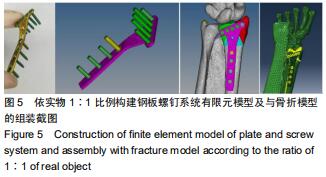
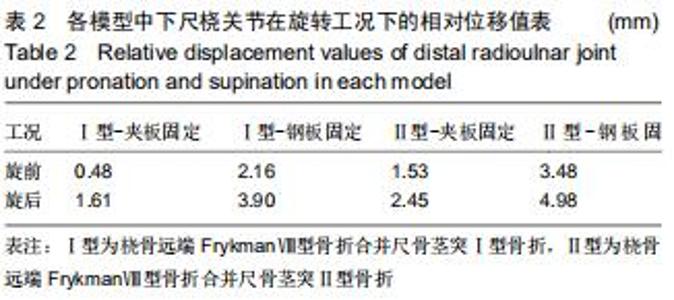
2.2 下尺桡关节在旋转工况下的相对位移变化 提取模型中立位时下尺桡关节内部尺、桡骨关节软骨部分,选取尺骨头几何中心在桡骨乙状切迹上的投影点为原始标志点。通过软件测量各模型在不同工况下标志点的位移变化值,就可以得出下尺桡关节内部尺、桡骨关节软骨部分相对位置变化,完成各模型下尺桡关节在不同工况中相对位移变化的采集[4]。结果显示在旋转工况下,夹板干预桡骨远端FrykmanⅧ型骨折合并尺骨茎突Ⅰ型及Ⅱ型骨折模型下尺桡关节发生的相对位移小于钢板干预的相对应骨折模型,见表2及图6,7,表明前者下尺桡关节比后者稳定,即夹板干预能增加尺骨茎突骨折后下尺桡关节的稳定性。在横向拉伸、旋前及旋后工况中,夹板干预桡骨远端FrykmanⅧ型骨折合并尺骨茎突Ⅰ型及Ⅱ型骨折模型尺骨茎突骨折端位移值小于钢板干预的相对应骨折模型,表明夹板干预可以增加尺骨茎突骨折端的稳定性,也可以再次佐证夹板作为弹性固定治疗桡骨远端骨折合并尺骨茎突骨折时能够提供尺侧柱的相对稳定性。 "
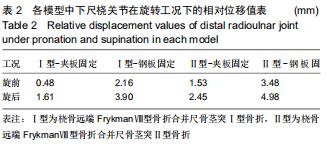
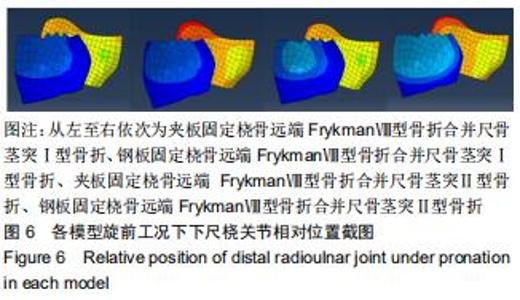
2.2 下尺桡关节在旋转工况下的相对位移变化 提取模型中立位时下尺桡关节内部尺、桡骨关节软骨部分,选取尺骨头几何中心在桡骨乙状切迹上的投影点为原始标志点。通过软件测量各模型在不同工况下标志点的位移变化值,就可以得出下尺桡关节内部尺、桡骨关节软骨部分相对位置变化,完成各模型下尺桡关节在不同工况中相对位移变化的采集[4]。结果显示在旋转工况下,夹板干预桡骨远端FrykmanⅧ型骨折合并尺骨茎突Ⅰ型及Ⅱ型骨折模型下尺桡关节发生的相对位移小于钢板干预的相对应骨折模型,见表2及图6,7,表明前者下尺桡关节比后者稳定,即夹板干预能增加尺骨茎突骨折后下尺桡关节的稳定性。在横向拉伸、旋前及旋后工况中,夹板干预桡骨远端FrykmanⅧ型骨折合并尺骨茎突Ⅰ型及Ⅱ型骨折模型尺骨茎突骨折端位移值小于钢板干预的相对应骨折模型,表明夹板干预可以增加尺骨茎突骨折端的稳定性,也可以再次佐证夹板作为弹性固定治疗桡骨远端骨折合并尺骨茎突骨折时能够提供尺侧柱的相对稳定性。 "
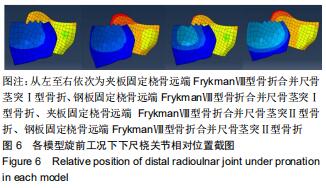
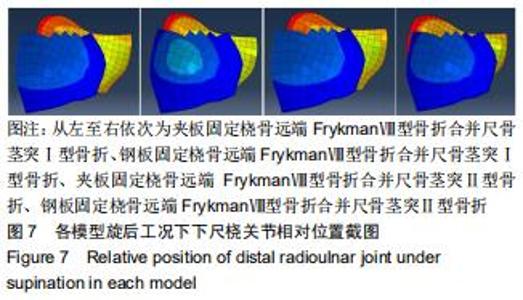
2.2 下尺桡关节在旋转工况下的相对位移变化 提取模型中立位时下尺桡关节内部尺、桡骨关节软骨部分,选取尺骨头几何中心在桡骨乙状切迹上的投影点为原始标志点。通过软件测量各模型在不同工况下标志点的位移变化值,就可以得出下尺桡关节内部尺、桡骨关节软骨部分相对位置变化,完成各模型下尺桡关节在不同工况中相对位移变化的采集[4]。结果显示在旋转工况下,夹板干预桡骨远端FrykmanⅧ型骨折合并尺骨茎突Ⅰ型及Ⅱ型骨折模型下尺桡关节发生的相对位移小于钢板干预的相对应骨折模型,见表2及图6,7,表明前者下尺桡关节比后者稳定,即夹板干预能增加尺骨茎突骨折后下尺桡关节的稳定性。在横向拉伸、旋前及旋后工况中,夹板干预桡骨远端FrykmanⅧ型骨折合并尺骨茎突Ⅰ型及Ⅱ型骨折模型尺骨茎突骨折端位移值小于钢板干预的相对应骨折模型,表明夹板干预可以增加尺骨茎突骨折端的稳定性,也可以再次佐证夹板作为弹性固定治疗桡骨远端骨折合并尺骨茎突骨折时能够提供尺侧柱的相对稳定性。 "
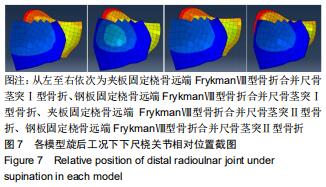
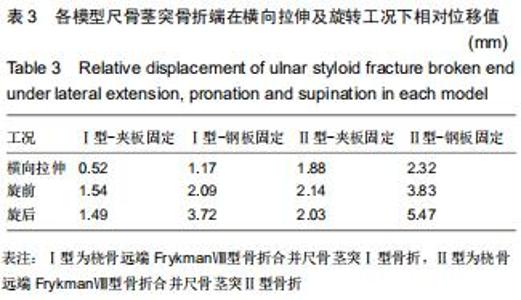
2.3 骨折模型中尺骨茎突骨折端位移的变化情况 在轴向压缩工况下,因为桡腕关节面承担了绝大部分的轴向应力,夹板及钢板固定干预的骨折模型中尺骨茎突骨折端相对位移无明显变化,但在横向拉伸及旋转工况下,骨折模型中尺骨茎突骨折端相对位移均出现了明显变化,具体数值见表3。结果可见在横向拉伸及旋转工况下,Ⅰ型骨折模型的尺骨茎突骨折端相对位移小于Ⅱ型骨折模型,表明前者骨折端相对稳定;夹板干预后骨折模型中尺骨茎突骨折端相对位移均变小,在旋后工况中为著,表明夹板干预可以增加尺骨茎突骨折端的稳定性。另外在旋后工况中,钢板干预模型尺骨茎突骨折端位移值随载荷变化波动较大;夹板干预模型骨折端位移值随载荷大致呈线性变化,见图8,这说明夹板能较好地维持骨折断端稳定,能减少在康复中因旋转运动造成的进一步损伤。 "
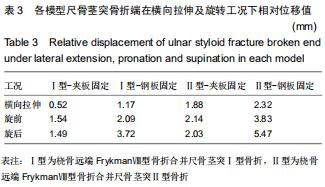
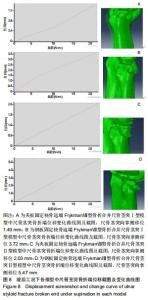
2.3 骨折模型中尺骨茎突骨折端位移的变化情况 在轴向压缩工况下,因为桡腕关节面承担了绝大部分的轴向应力,夹板及钢板固定干预的骨折模型中尺骨茎突骨折端相对位移无明显变化,但在横向拉伸及旋转工况下,骨折模型中尺骨茎突骨折端相对位移均出现了明显变化,具体数值见表3。结果可见在横向拉伸及旋转工况下,Ⅰ型骨折模型的尺骨茎突骨折端相对位移小于Ⅱ型骨折模型,表明前者骨折端相对稳定;夹板干预后骨折模型中尺骨茎突骨折端相对位移均变小,在旋后工况中为著,表明夹板干预可以增加尺骨茎突骨折端的稳定性。另外在旋后工况中,钢板干预模型尺骨茎突骨折端位移值随载荷变化波动较大;夹板干预模型骨折端位移值随载荷大致呈线性变化,见图8,这说明夹板能较好地维持骨折断端稳定,能减少在康复中因旋转运动造成的进一步损伤。 "
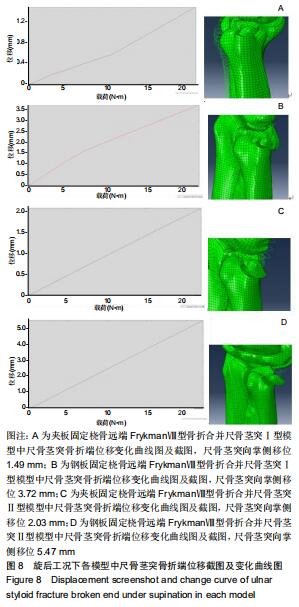
|
[1] WILLIS AA, KUTSUMI K, ZOBITZ ME, et al. Internal fixation of dorsally displaced fractures of the distal part of the radius.A biomechanical analysis of volar plate fracture stability.J Bone Joint Surg Am. 2006;88(11):2411-2417.
[2] RIKLI DA, REGAZZONI P. Fractures of the distal end of the radius treated by internal fixation and early function.A preliminary report of 20 cases.J Bone Joint Surg Br.1996;78: 588-592.
[3] 李永耀,赵勇,程灏,等.夹板固定治疗桡骨远端FrykmanⅧ型骨折34例[J].中国中西医结合外科杂志,2018,24(1):47-51.
[4] 李永耀,程灏,赵勇,等.夹板固定治疗尺骨茎突骨折的三维有限元分析[J].中国组织工程研究,2018,22(11):1737-1742.
[5] 钦斌,黄永火,欧阳羽,等.轴向应力作用下的舟骨有限元分析[J].第三军医大学学报,2010,15(11):1213-1215.
[6] 李想.小夹板治疗老年桡骨远端骨折中夹板束缚力的量化研究[D].广州:广州中医药大学,2011.
[7] 徐振东,刘曦明,蔡贤华,王志华,董鹏飞.LCP“动力化”一折端微动及应力的有限元分析[J].中国矫形外科杂志,2017,25(8):747-751.
[8] 尹峰,王晓东,梁炜,任龙韬.建立锁骨个性化锁定接骨板模型及有限元分析[J].中国组织工程研究,2016,20(35):5244-5249.
[9] SYNN AJ, MAKHNI EC, MAKHNI MC, et al. Distal radius fractures in older patients: is anatomic reduction necessary? Clin Orthop Relat Res.2009;467(6):1612-1620.
[10] KIHARA H, SHORT WH, WERNER FW, et al. The stabilizing mechanism of the distal radioulnar joint during pronation and supination.J Hand Surg Am.1995;20(6):930-936.
[11] 张俊,厉国定,尹伟忠,等.尺骨茎突骨折与否及不同分型对桡骨远端骨折术后疗效的影响[J].中国骨与关节损伤杂志,2019,34(3): 321-323.
[12] KANG YK, PARK HC, YOUM Y, et al. Three dimensional shape reconstruction and finite element analysis of femur before and after the cementless type of total hip replacement. J Biomed Eng. 1993;15(6):497-504.
[13] LOTZ JC, CHEAL EJ, HAYES WC. Fracture Prediction for the proximal femur using finite element models:partl-linear analysis. J Biomech Eng.1991;11(2):353-360.
[14] 郭欣,樊瑜波,李宗明.掌骨受轴向压力作用下的腕部生物力学分析[J].航天医学与医学工程,2008,21(1):45-49.
[15] 魏成建,陶宝琛,张满臣,等.动力气囊压垫纠正桡骨远端AO C3.1型骨折残余侧方移位的三维有限元分析[J].医用生物力学,2018, 33(1):13-17.
[16] HOSSEINI HS, DÜNKI A, FABECH J, et al. Fast estimation of Colles’ fracture load of the distal section of the radius by homogenized finite element analysis based on HR-pQCT. Bone.2017;97(1):65-75.
[17] 陶宝琛,魏成建,白杨.三维有限元分析在桡骨远端骨折中的应用进展[J].山东中医杂志,2016,35(7):659-662.
[18] CILLA M, CHECA S, PREININGER B, et al. Femoral head necrosis: A finite element analysis of common and novel surgical techniques.Clin Biomech (Bristol, Avon).2017; 48(7):49-56.
[19] WANG B, SUN P, XIE X, et al. A novel combined hemipelvic endoprosthesis for peri-acetabular tumours involving sacroiliac joint: a finite element study.Int Orthop.2015;39(11): 2253-2259.
[20] TSUBONE T, TOBA N,TOMOKI U, et al. Prediction of fracture lines of the calcaneus using a three-dimensional finite element model.J Orthop Res.2018;37(2):483-489.
[21] AYALON O, MARCANO A, PAKSIMA N, et al. Concomitant ulnar styloid fracture and distal radius fracture portend poorer outcome.Am J Orthop.2016;45(1):34-37.
[22] 靳家骋,张坤鹏,黄富国.合并尺骨茎突骨折对桡骨远端骨折预后影响的Meta分析[J].中国循证医学杂志,2014,14(6):729-733.
[23] STOFFELEN D, DE SMET L, BROOS P. The importance of the distal radioulnar joint in distal radial fractures.J Hand Surg Br. 1998;23(4):507-511. [24] 张光辉.桡骨远端骨折合并的尺骨茎突骨折内固定与否对腕关节功能的影响[J].临床医药文献电子杂志, 2016,3(41): 8162-8164. |
| [1] | Chen Xinmin, Li Wenbiao, Xiong Kaikai, Xiong Xiaoyan, Zheng Liqin, Li Musheng, Zheng Yongze, Lin Ziling. Type A3.3 femoral intertrochanteric fracture with augmented proximal femoral nail anti-rotation in the elderly: finite element analysis of the optimal amount of bone cement [J]. Chinese Journal of Tissue Engineering Research, 2021, 25(9): 1404-1409. |
| [2] | Cai Qunbin, Zou Xia, Hu Jiantao, Chen Xinmin, Zheng Liqin, Huang Peizhen, Lin Ziling, Jiang Ziwei. Relationship between tip-apex distance and stability of intertrochanteric femoral fractures with proximal femoral anti-rotation nail: a finite element analysis [J]. Chinese Journal of Tissue Engineering Research, 2021, 25(6): 831-836. |
| [3] | Song Chengjie, Chang Hengrui, Shi Mingxin, Meng Xianzhong. Research progress in biomechanical stability of lateral lumbar interbody fusion [J]. Chinese Journal of Tissue Engineering Research, 2021, 25(6): 923-928. |
| [4] | Liu Zhao, Xu Xilin, Shen Yiwei, Zhang Xiaofeng, Lü Hang, Zhao Jun, Wang Zhengchun, Liu Xuzhuo, Wang Haitao. Guiding role and prospect of staging and classification combined collapse prediction method for osteonecrosis of femoral head [J]. Chinese Journal of Tissue Engineering Research, 2021, 25(6): 929-934. |
| [5] | Chen Lu, Zhang Jianguang, Deng Changgong, Yan Caiping, Zhang Wei, Zhang Yuan. Finite element analysis of locking screw assisted acetabular cup fixation [J]. Chinese Journal of Tissue Engineering Research, 2021, 25(3): 356-361. |
| [6] | Shu Qihang, Liao Yijia, Xue Jingbo, Yan Yiguo, Wang Cheng. Three-dimensional finite element analysis of a new three-dimensional printed porous fusion cage for cervical vertebra [J]. Chinese Journal of Tissue Engineering Research, 2021, 25(24): 3810-3815. |
| [7] | Zhu Yun, Chen Yu, Qiu Hao, Liu Dun, Jin Guorong, Chen Shimou, Weng Zheng. Finite element analysis for treatment of osteoporotic femoral fracture with far cortical locking screw [J]. Chinese Journal of Tissue Engineering Research, 2021, 25(24): 3832-3837. |
| [8] | Liu Jinyu, Ding Yiwei, Lu Zhengcao, Gao Tianjun, Cui Hongpeng, Li Wen, Du Wei, Ding Yu. Finite element biomechanical study of full endoscopic fenestration decompression for cervical spondylotic myelopathy [J]. Chinese Journal of Tissue Engineering Research, 2021, 25(24): 3850-3854. |
| [9] | Qin Wan’an, Cai Zhouyu, Wei Gejin, Lin Zhoudan. Finite element analysis of absorbable screws and ethibond sutures for the treatment of humerus shaft fractures caused by grenade throwing [J]. Chinese Journal of Tissue Engineering Research, 2021, 25(24): 3855-3859. |
| [10] | Cai Qunbin, Yang Lijuan, Li Qiumin, Chen Xinmin, Zheng Liqin, Huang Peizhen, Lin Ziling, Jiang Ziwei . Feasibility of internal fixation removal of intertrochanteric fractures in elderly patients based on fracture mechanics [J]. Chinese Journal of Tissue Engineering Research, 2021, 25(21): 3313-3318. |
| [11] | Wei Yuanbiao, Guo Huizhi, Zhang Shuncong. Finite element analysis of cortical bone trajectory screw fixation on adjacent segments [J]. Chinese Journal of Tissue Engineering Research, 2021, 25(18): 2799-2804. |
| [12] | Qu Xingyue, Zhou Jianqiang, Xu Xuebin, Zhang Shaojie, Li Zhijun, Wang Xing. Finite element analysis of screw-bone anti-pullout in four models of anterior lower cervical fixation in children [J]. Chinese Journal of Tissue Engineering Research, 2021, 25(18): 2816-2821. |
| [13] | Ruan Hanjiang, Jin Genyang, Li Xinwu, Yao Jian, Wu Peng, Zhang Yin, Zhang Shuai, Xiao Jun . Biomechanical properties of three types of posterior single-segment fixation for type II Hangman’s fracture [J]. Chinese Journal of Tissue Engineering Research, 2021, 25(15): 2309-2314. |
| [14] | Fan Zhirong, Su Haitao, Zhou Lin, Huang Huida, Zhou Junde, Jiang Tao, Liu Zitao. Finite element analysis of novel femoral neck system for unstable femoral neck fractures [J]. Chinese Journal of Tissue Engineering Research, 2021, 25(15): 2321-2328. |
| [15] | Han Shichong, Li Chang, Xing Haiyang, Ge Wenlong, Wang Gang . Finite element analysis of two internal fixation methods for treating extra-articular proximal tibial fractures [J]. Chinese Journal of Tissue Engineering Research, 2021, 25(15): 2329-2333. |
| Viewed | ||||||
|
Full text |
|
|||||
|
Abstract |
|
|||||
